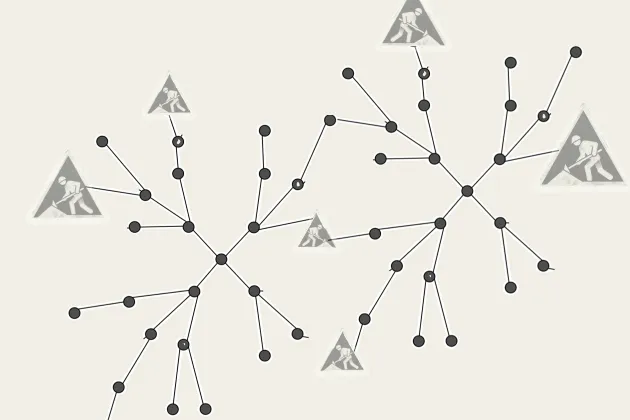May
How Networks Work

Fika-to fika workshop by Lund University Profile Area Natural and Artificial Cognition.
Networks are ubiquitous in both nature and technology, spanning scales from the microscopic to the macroscopic. Examples include metabolic and gene expression networks within cells, neural and vascular networks, traffic and social networks, and electric power distribution grids. The study of network dynamics has emerged as a key paradigm in understanding complex systems. Networks are analyzed using techniques from various scientific disciplines, making them an ideal focal point for interdisciplinary research.
This one day (“fika-to-fika”) workshop brings together researchers from across the NAC Plane* who are working on network-related topics. It will include experts on modeling power-supply systems, social networks, neuroscience, biology, biomedicine, as well as investigators researching network theory and network dynamics in general.
When: 27 May 2024 at 9.30 to 15.30
Where: M:Teknodromen in M-building, Klas Anshelms väg 6 / Ole Römers väg 1, Lund, Sweden
Primary audience researchers (estimate: 50-90 attendants)
To participate is free of charge. Sign up for participation at ai.lu.se/2025-05-27/registration
Programme outline - preliminar
9.30: Check-in, coffee
10.00 Morning session
10.00-10.10 Welcome & introduction
10.10 Keynote: Petter Holme, Professor, Department of Computer Science, Aalto University
Title and abstract tba
11:00 Lightning talks
Julia Adlercreutz – Finding network structure in the Linear Quadratic Regulator
Emma Tegling -- Degree-bounded networks: dynamic fragilities and structural robustness
Luka Bakovic -- Multipolar dynamics of social segregation
Erik Martens -- TBA
Per Hälje -- TBA
12.00-13.00: Lunch sandwich / mingle
13.10 Afternoon session
13.10: Keynote 2: Kim Sneppen, Professor, Niels Bohr Institute, Biocomplexity; Copenhagen University
Talkers and Listeners in Social and Biological Networks
Abstract: Human communication often self-organizes around asymmetrical roles: talkers, who dominate speaking time and attract attention, and listeners, who form the attentive fabric of social life. This talk introduces an agent-based model that captures how disparities in expression and attention drive emergent social structures. It is suggested that social hierarchies easily emerge from repetitive self-referential speech, whereas listeners' attention and memory sustain cohesion across a social network.
In a broader context, the asymmetry between network nodes that regulate and network nodes that make things work is universal across life. In ecology, it is inherent in the directed links between a predator and its prey. In regulatory genetic networks, it is reflected in the partially modular hubs of genes around transcription factors and their target genes. I will give examples of regulatory gene networks, with their interplay of hubs and combinations of positive and negative regulation. As a final lesson from network biology, I will emphasize feedback types and the central role of positive feedback in sustaining complex life.
14.00 Lightning talks
Speakers and titles
- Ask Hällström – Impedance matching for regulating vehicle platoons
- Richard Pates – Distributed optimal control via positive cones
- Jonas Hansson – Scalable control for network systems: Coordination through local cooperation
- Additional speakers TBC
15.00 Summary
15.15 - 15.45: Coffee / mingle
Organisation
The workshop is organised by the Lund University Profile Area Natural and Artificial Cognition
- Erik A. Martens, Senior lecturer, Applied Mathematics, Lund University
- Emma Tegling, Senior lecturer, Automatic Control, Lund University
- Richard Pates, Senior lecturer, Automatic Control, Lund University
- Pär Halje, Integrative Neurophysiology Lund University, Lund University
- Jonas Wisbrant, Natural and Artificial Cognition and AI Lund
* The NAC plane is one of several ways to try to span and describe the research within Lund University's profile area for natural and artificial cognition (NAC). Imagine a two-dimensional matrix in which one axis (often y) you have the concepts of artificial and natural cognition, i.e. different artificial or biological cognitive and more or less autonomous agents or systems. On the other axis (often x) you have how many such agents or systems you want to study, one by one, two by two, or many; sometimes very many, such as brain cells or nodes on the Internet. Research on humans interacting with robots ends up in the middle of the matrix.
If you have read to here and want to know more about Lund University's profile area for natural and artificial cognition, you will find the researchers and much of our research on https://portal.research.lu.se/ :-)
About the event
Location:
M:Teknodromen, M-building LTH, Klas Anshelms väg 6 / Ole Römers väg 1, Lund, Sweden
Contact:
Jonas [dot] Wisbrant [at] control [dot] lth [dot] se

